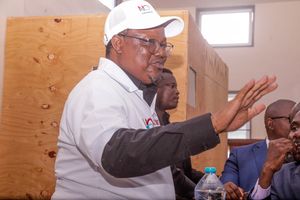YOUR BUSINESS IS OUR BUSINESS: AfDB, Unido to help industrialise Africa
What you need to know:
- The ‘Manufacturing’ category mainly consists of food-processing (24 per cent); textiles and clothing (10 per cent); chemicals (8.5 per cent), and ‘others’ (0.5 per cent).
The Industrial sector of Tanzania’s economy largely comprises Manufacturing (53 per cent); Processing (43 per cent), and Assembling (4 per cent).
The ‘Manufacturing’ category mainly consists of food-processing (24 per cent); textiles and clothing (10 per cent); chemicals (8.5 per cent), and ‘others’ (0.5 per cent).
But, how much of that has salvaged the country from the socio-economic quagmire it has been marking time in?
For decades agriculture was the mainstay of the economy, and manufacturing was centered round the processing of local agricultural produce.
Indeed, major industrial manufacturing never really took firm hold and, even as of today, a majority of the country’s agricultural crops are still marketed in their raw form.
The little that’s being done in the name of ‘industrialisation’ today is small-scale value-addition to agricultural produce, mostly done at the secondary level.
In the event, the Tanzanian agriculture value-added net output rose by 61 per cent in five years, from $8.6 billion in 2009 to $13.8 billion in 2014. Currently, value-added products include cotton yarn, manufactured coffee and tobacco, sisal products (yarn and twine), and wheat flour.
In general, value-added manufacturing contribution to Tanzania’s GDP in 2016 was a respectable 5.5433 per cent, according to the World Bank. [See /tradingeconomics.com/tanzania/manufacturing-value-added-percent-of-gdp-w...>].
Although the 5th-phase Government of President John Magufuli is being trumpeted for its industrialization drive today, the current agenda was actually set by his predecessor, immediate-past President Jakaya Kikwete (2005-2015).
Speaking during the ‘USAID Forum on Frontiers in Development: Ending Extreme Poverty’ in Washington-DC on Sept. 19, 2014, Kikwete stated that the Tanzania government “would focus on developing an industrial economy, concentrating on growth of the industrial sector and natural gas in order to meet the goals of the second five-year plan of the National Development Vision-2025…”
In the event, “the second five-year plan (2016/17-2020/21) would focus on transforming the country into a competitive semi-industrialised economy with the objective of creating new job opportunities. Tanzania would then be characterised by high-quality livelihoods and a competitive semi-industrialized economy,” then-President Kikwete said. [See /www.tanzaniainvest.com/economy/tanzania-vision-2025-focus-on-industry-natural-gas>].
Fortunately for Tanzania, the successor government of President Magufuli has latched on to the industrialisation agenda, driving it pell-mell, hopefully, on the road to a semi-industrialised, middle-income economy by the National Development Vision-2025 deadline.
Perhaps fortunately again for Tanzania, the African Development Bank (AfDB) and the United Nations Industrial Development Organization (Unido) have joined forces to accelerate Africa’s industrialisation.
In a MoU signed in Busan, South Korea, on May 21 this year on the sidelines of the annual meetings of the Boards of Governors of the AfDB Group – whose theme was ‘Accelerating Africa’s industrialization’ – AfDB and Unido agreed to “step up collaboration to boost Africa’s industrialisation…”
The MoU “facilitates cooperation on joint activities of shared interest in areas such as agro-industry development; circular economy; eco-industrial parks; investment in innovation and technology; enterprise development; trade and capacity-building, and access to finance…”
Where does Tanzania’s industrialisation agenda fit in here, pray? Cheers!




